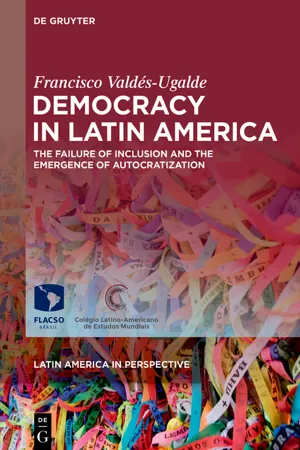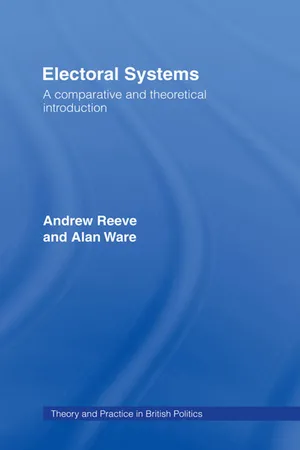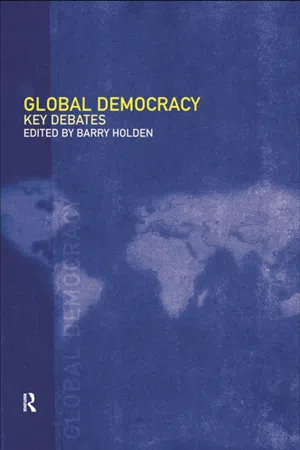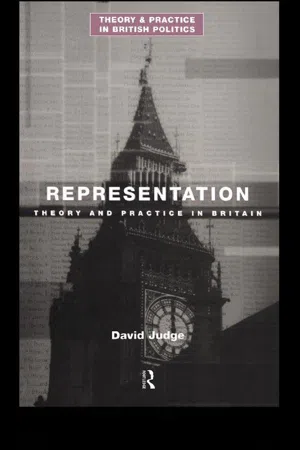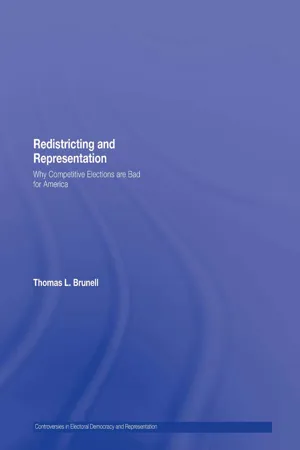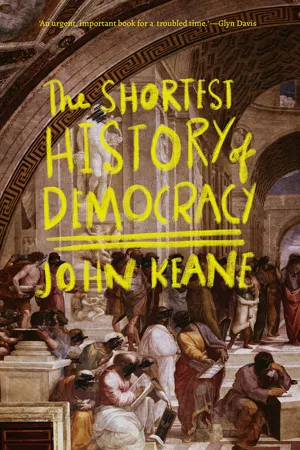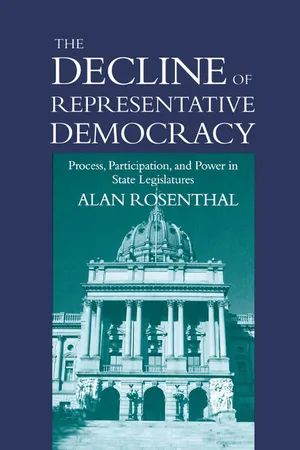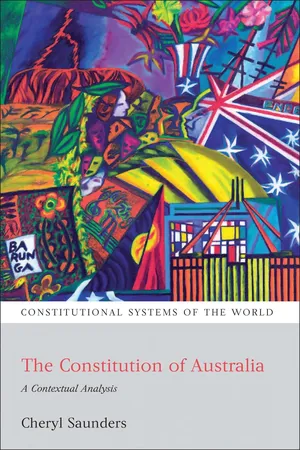Politics & International Relations
Representative Democracy
Representative democracy is a form of government in which citizens elect representatives to make decisions on their behalf. These representatives are accountable to the people and are expected to act in the best interests of their constituents. This system allows for the participation of citizens in the decision-making process while also providing a level of expertise and efficiency in governance.
Written by Perlego with AI-assistance
Related key terms
11 Key excerpts on "Representative Democracy"
- eBook - ePub
Open Democracy
Reinventing Popular Rule for the Twenty-First Century
- Hélène Landemore(Author)
- 2020(Publication Date)
- Princeton University Press(Publisher)
For example, perhaps globalization does not simply “happen” to democracies, an external factor they have no power over, but is a goal pursued by the representative elites at the helm of representative democracies, if necessary, against the interests and desires of their populations (see Slobodian 2018). From this perspective, globalization, as well as its resulting economic inequalities in many democracies, is closer to an internal problem than an exogenous one. It should be addressed via a reflection about political and legal institutions and the ideologies that undergird them (see also Piketty 2019). 14 To understand what is wrong with Representative Democracy on that reading, we need to turn from empirical political science to history and normative political theory. Let us therefore take a closer look at what Representative Democracy means, both historically and conceptually. The Crisis of Representative Democracy: Conceptual The form of democracy that re-emerged in the eighteenth century (after a more than 2,000-year eclipse since the Greeks) at the time of the French and American revolutions is the historical paradigm known as Representative Democracy. There are various reasons to think that even the most democratized version of such a system—with full enfranchisement and no restriction on who can run for office—cannot fully measure up to the ideal of popular rule, which we defined earlier, as a regime in which “all the members are equally entitled to participate in the association’s decision [including deliberation] about its policies” (after Dahl 1989). The problem with democracy today might thus be the price we pay for conceptual mistakes committed at the inception of this regime form, which no amount of marginal institutional reform (e.g., banning money from politics) can properly fix. According to Dahl himself, most existing democracies fail one or more of the five procedural criteria he associated with his definition of democracy (see also Landemore 2017c) - eBook - ePub
Democracy in Latin America
The Failure of Inclusion and the Emergence of Autocratization
- Francisco Valdés-Ugalde(Author)
- 2023(Publication Date)
- De Gruyter(Publisher)
Chapter 3 What is Representative Democracy and how do we measure it?Note: The literature review and methodological design used in this chapter benefited greatly from the input of Georgina Flores-Ivich. What I argue herein is my sole responsibility.Political representation is a circular process (susceptible to friction) between state institutions and social practices. As such, Representative Democracy is neither aristocratic nor a defective substitute for direct democracy, but a way for democracy to constantly recreate itself and improve. Popular sovereignty, understood as an as if regulating principle guiding citizens’ political judgment and action, is a central motor for democratizing representation.Nadia Urbinati3.1 Measuring democracy
Few concepts have been discussed and evaluated as much as the concept of democracy. Efforts to measure it have generated an abundant literature and led to important international projects aimed at developing indicators to classify countries according to their level of democracy. This is an ongoing discussion that began more than 30 years ago. The debates have acquired different dynamics and the accumulated knowledge continues to generate important projects aimed at resolving theoretical, methodological, and technical problems that hinder the measurement of this concept.The great majority of debates about the measurement of democracy have been framed in terms of its conceptualization. There is no single definition of democracy; on the contrary, there are multiple theoretical approaches to address this concept and diverse measurement efforts have been attempted (Dahl, 1971 ; Przeworski et al. 2000 ; Sartori, 1987 ; Schmitter and Karl, 1991 ; Saward, 1994 ; Schumpeter, 1992 ; Vanhanen, 1997 ; Lindberg et al. 2014 ; IDEA, 2017 ; Lührmann et al. 2017 ; Skaaning et al. 2015 ; Boix et al. 2013 ; Bertelsmann Stiftung, 2020 ). Despite the abundant literature on the topic, consensus still seems distant. Social scientists agree on the need to construct better ways of measuring democracy. The only consensus appears to indicate that the difficulty in measurement lies in its conceptualization and definition. This dilemma is what was called the “defining enigma” (Coppedge et al. 2011 - eBook - ePub
- Andrew Reeve, Alan Ware(Authors)
- 2013(Publication Date)
- Routledge(Publisher)
In this chapter, we have looked at many different roles the electoral system has been assigned by those who see it as a vital component of a democratic system. It is a familiar truth that a tool designed to do many jobs may not do any of them particularly well. Two major conclusions follow from this. The first is that claims about what the electoral system 'reveals' should be treated with great scepticism. The second is that even if there are limits to what can be conveyed by elections, we ought not to be indifferent to where those limits come, and we ought to try to compensate for the limitations of the electoral system in other areas of our political practice. (For example, we might try to overcome defects in one area of interest reconciliation, identified above, in another area.)We may conclude by reviewing those multiple roles, their relation to democracy, and the levels of aggregation involved. In a direct democracy, outcomes follow from an aggregation of voters' opinions or judgements - about policy, law or common action of some kind. These judgements may be based on a consideration of self-interest or general interest. This sort of direct democracy is defended by reference to ideals of self-government, popular sovereignty, participation and political equality. Representative government is pragmatically defended as the nearest practical approach to direct democracy, and hence the electoral arrangements are supposed to embody, as far as possible, the democratic ideals. Instead of literal self-rule, it is rule by those chosen by the people; instead of continuous participation in policy formation, it provides an opportunity to express opinions as far as is practicable; universal franchise contributes to popular sovereignty. The electoral system is thus a surrogate for direct democracy, and votes are interpreted as views about policies.But representative government, as constituted in Britain, brings with it other possibilities. An election 'selects' a Prime Minister, and the party of government. It makes the rulers accountable to the people. It is taken to legitimize the use of political power. An election also determines individual representatives, and the composition of the representative assembly. The problem of aggregation, under this practice, is quite different from that in direct democracy. First, voters are faced with a package of policies, not individual decisions - the policies themselves are aggregated. Secondly, individual MPs are chosen by aggregating votes in particular constituencies. Thirdly, the representative assembly is an aggregation of individual MPs. Fourthly, the government emerges as a consequence of the composition of the representative assembly. The electorate as a whole - eBook - ePub
Global Democracy
Key Debates
- Barry Holden(Author)
- 2013(Publication Date)
- Routledge(Publisher)
The theory of liberal or Representative Democracy fundamentally shifted the terms of reference of democratic thought: the practical limits that a sizeable citizenry imposes on democracy — which had been the focus of so much critical (anti-democratic) attention — were thought to be eradicable. Representative Democracy could now be celebrated as both accountable and feasible government, potentially stable over great territories and time spans (see Dahl 1989 : 28–30). As one of the best-known advocates of the representative system put it, ‘by ingrafting representation upon democracy’ a system of government is created that is capable of embracing ‘all the various interests and every extent of territory and population’ (Paine 1987 : 281). Representative Democracy could even be heralded, as James Mill wrote, ‘as the grand discovery of modern times’ in which ‘the solution of all difficulties, both speculative and practical, would be found’ (quoted in Sabine 1963 : 695). Accordingly, the theory and practice of democratic government broke away from its traditional association with small states and cities, opening itself to become the legitimating creed of the emerging world of modern nation-states. Built, as it was, against the background of the formation of the modern nation-state, the development of liberal democracy took place within a particular conceptual space (cf. Walker 1988 ; Connolly 1991 ; McGrew 1997b). Modern democratic theory and practice was constructed upon national, territorial foundations. National communities, and theories of national communities, were based on the presupposition that political communities could, in principle, control their destinies and citizens could come to identify sufficiently with each other such that they might think and act together with a view of what was best for all of them; that is, with a view of the common good (Sandel 1996 : 202) - eBook - ePub
Representation
Theory and Practice in Britain
- David Judge(Author)
- 2005(Publication Date)
- Routledge(Publisher)
representative government. Both of which have inherent within them the initial ‘present/absent’ paradox noted above, where the people (however conceived and constituted) are held to be present through their representatives (however conceived and constituted) in the making of political decisions—yet are not literally present at the point of decision. They are, therefore, simultaneously included and excluded from the process of decision. Exactly where the emphasis is placed—upon inclusion/ participation, or exclusion/non-participation—depends upon one’s ideological predilections and one’s conception of democracy.From starting with a simple etymological statement about the meaning of representation we have immediately become immersed in the exceedingly deep and complex conceptual waters of ‘democracy’. In fact we cannot avoid being embroiled in these waters, as one variant of democracy has at its very core—as one of its ‘indispensable components’— the notion of representation and a representative assembly. This variant— liberal democracy—justifies representation through an elected assembly ‘as the most effective device for reconciling the requirements of popular control and political equality with the exigencies of time and the conditions of the modern territorial state’ (Beetham 1992a:41). Exactly what these requirements and exigencies are we will return to shortly—but first we need to examine the democratic claims made on behalf of representation in the term ‘Representative Democracy’.Democracy
Democracy, as Bernard Crick observed ‘is perhaps the most promiscuous word in the world of public affairs’ (1964:56). Indeed, the various usages of the word, both throughout history and in the modern world, have led some commentators to maintain that there is little in common between these variants of democracy other than the word itself (see Parry and Moran 1993:3). Indeed, the problem starts with the word itself, for although deceptively simple in its Greek origin demokratia—drawn from demos (people) and Kratos (rule)—their combination, in ‘people rule’, raises all sorts of questions about ‘who’ the people are and ‘how’ they rule? One perfectly defensible answer to these questions is to argue that democracy is an ideal, that it does not exist in practice (see Burnheim 1985:1). However, such a simple answer generates its own complexity and results in a new conceptual language of, for example, ‘polyarchy’ (Dahl 1989) or ‘demarchy’ (Hayek 1982:39–40; Burnheim 1985:9), designed to differentiate practical political systems, from the ideal. What both of these concepts have in common is the starting premise that ‘democracy’—defined as rule by the people—is impractical in the modern nation-state. At its simplest there are limits, both theoretical and practical, as to how far political participation (if this is how rule by the people is to be conceived) can be effective in a diverse and large mass public. Or as Dahl puts it: ‘The theoretical limit of effective political participation, even with modern electronic means of communication, rapidly diminishes with scale’ (1989: 217). A fully participatory political system, where all citizens participate directly in collective decisions, is thus seen to be an ideal. What is required is some practical institutional structure which will promote the ‘democratisation’ of decision making in order to ensure ‘the highest feasible attainment of the democratic process in the government of a country’ (Dahl 1989:222). It should be noted, however, that the claim is not that this is democracy itself, but that polyarchy is a process as close as can be achieved in a large scale polity. Similarly with ‘demarchy’, we do not need to understand the complexities of this system other than to understand that it is not a system of direct - eBook - ePub
Redistricting and Representation
Why Competitive Elections are Bad for America
- Thomas Brunell(Author)
- 2010(Publication Date)
- Routledge(Publisher)
1 In reality it is likely that virtually every elected representative sometimes acts as a trustee and other times as a delegate. If a member of Congress is voting on something that his constituents have no preference about or are indifferent between the two choices, the elected official makes a decision based on other factors (e.g. his own ideology, interest group lobbying, deal-making, etc.).Regardless of how one approaches the concept of representation, it is clear that electing representatives is one of the most significant forms of democratic action that citizens can have. Robert Dahl puts it nicely in trying to describe how best to design a democracy: "The only feasible solution, though it is highly imperfect, is for citizens to elect their top officials and hold them more or less accountable through elections by dismissing them, so to speak, in subsequent elections."2 Dahl goes on to list several criteria that elections must meet: "every citizen must have an equal and effective opportunity to vote, and all votes must be counted as equal. Free elections mean citizens can go to the polls unconcerned about reprisal and fair means each vote weighted equally."3 In this chapter I review some of the current theories of political representation and then present my own approach. My approach is not necessarily new or novel, but it is straightforward and intuitive.Pitkin's (1967) views on representation have played a major role in shaping the way in which scholars conceptualize what representation is and what it ought to be. In The Concept of Representation, she offers four different views and definitions of representation: formalistic representation, descriptive representation, symbolic representation, and substantive representation. Each of these provides different views of what representation is, as well as different criteria for assessing how well a representative represents her constituents. Each is worth examining in turn.Formalistic representation, as Pitkin defines it, really has two dimensions. The first has to do with authorization and is defined "in terms of a transaction that takes place at the outset, before the actual representation begins."4 Someone is authorized to do something via some set of institutional arrangements, but there are limits to what the representative can do. Within the competences of the initial authorization the "representative can do whatever he pleases," but if the representative does something outside of the prescribed limits, Pitkin says that "he no longer represents." The second dimension of formal representation is related to accountability. Here the central notion of representation revolves around holding the elected official accountable for what he has done. So the representative ought to be responsive to his constituents and the constituents ought to have some method of sanctioning the representative (such as removing him from office). Pitkin argues that these two forms of formal representation are in a sense diametrically opposed to one another—"whereas authorization theorists see the representative as free, the represented as bound, accountability theorists see precisely the converse."5 - eBook - ePub
- John Keane(Author)
- 2022(Publication Date)
- Black Inc.(Publisher)
habeas corpus (prohibitions upon torture and imprisonment) and, much later, elected governments that provided public transportation, parks and libraries for the use and enjoyment of their citizens. The point is that the book of electoral democracy lacked a consistent plot. There were many loose pages, odd paragraphs, a few completed but mostly unfinished outlines of possible themes. But amid all the clutter there was one common theme that lived on until the early decades of the twentieth century: democracy came to mean the self-government of people by representatives chosen in periodic elections.As a practical way of handling power, electoral democracy proved that not everything turns full circle, and that new things do happen under the sun. It triggered great political disputes, centred on the thorny question of the meaning of representation. Lives were upended by revolutions. Blood was spilled. There were times, as in the early parliaments of northern Spain, when representatives broke the mandate of peaceful debate, fighting with fists and swords over two broadly conflicting definitions of representation. Were they mere servants and mouthpieces of their constituents, who needed to keep them on a short leash, or were they to be treated as free-spirited guardians of the whole political community? Should representatives have a set of carefully worded, binding instructions (poderes), forcing them to do as they were told? Was it best practice to give them a grilling when they returned from a session of parliament, as frequently happened in the Catalonian town of Barcelona, which used a permanent standing committee – Vintiquatrena de Cort, the Commission of the 24 – to keep tabs on its representatives’ public and private lives? Were they sometimes obliged to say no to their constituents, to stand above the fray and work selflessly for the higher political good? If so, might unanimity on important measures be mandatory? Might consensus sometimes require the physical ejection of recalcitrants from parliament, kicking and shouting? How sensible was the method used by the cortes of Aragon, which elected officers to vet representatives by putting them through a test, known as the habilitacion - eBook - ePub
The Decline of Representative Democracy
Process, Participation, and Power in State Legislatures
- Alan Rosenthal(Author)
- 1997(Publication Date)
- CQ Press(Publisher)
CHAPTER 1
Shifting Bases of Representation
Americans feel they have lost control of their government. Indeed, they no longer regard it as their government, serving their interests, but rather as a government of others serving special interests. For many members of the public in states across the nation, even the legislative branch of government, designed to be closest to the people, is no longer considered democratic.The irony of this perception is that government, the first branch in particular, has in recent years become more, not less, democratic. “While Americans feel increasingly powerless, cynical, and frustrated about government,” writes Lawrence Grossman, “the distance between the governed and those who govern is actually shrinking dramatically.”1 If by democracy we mean, among other things, rule by the people and political equality, then legislatures have been moving in a decidedly democratic direction. In fact, the very nature of representation is undergoing democratization, and more democracy rather than less can be anticipated in the near future.MODELS OF DEMOCRACY
According to Robert Dahl, democracy is characterized by a distinctive set of institutions and practices, a body of rights, and a process of making collective and binding decisions. Generally, democracy (or “polyarchy,” as Dahl refers to democracy in actual practice) requires officials who are elected; free and fair elections; inclusive suffrage; the right to run for office; freedom of expression; authoritative sources of information; and autonomy of associations. Presidential, congressional, or parliamentary government may fulfill these requirements. Form is not fundamental as long as other conditions are met. Anthony King portrays two models that apply nicely to the legislative branch. The first he calls the “division of labor” model, in which there are governors on the one hand and governed on the other. The function of the former is to make decisions in what they believe to be the states best interests. The function of the latter is not to determine policy, but to choose who will do so. In this model, governors need not be responsive to public opinion. The second model is that of “agency,” according to which those who govern function as agents of the people who are governed. In this model, governors must not only heed public opinion but also reflect citizen views in a narrower sense.2 Another model, which can be labeled “direct democracy,” is one in which no middlemen are necessary to act on behalf of the demos - eBook - ePub
The Constitution of Australia
A Contextual Analysis
- Cheryl Saunders(Author)
- 2010(Publication Date)
- Hart Publishing(Publisher)
4
Representative Democracy
Principle – Institutions – Legislative Function – Political RightsI. PRINCIPLE
A. Significance
R EPRESENTATIVE DEMOCRACY IS one of the pillars of the Australian constitutional system.1 It is secured through theParliaments, which in Australia are the only elected institutions above the local level of government. It is twinned with the principle of responsible government, under which the executive government holds office because it has the support of a majority in the House of Parliament deemed to be the more representative, described in Australia as the ‘lower’ House. Representative Democracy nevertheless is a critical principle in its own right. It is the source of legitimacy for both parliament and government. It provides the justification for the supremacy of the legislature in the exercise of its law-making function and the basis for the assumption that this power will not be abused.2 Together with responsible government and the rule of law, it provides a foundation for an approach to the protection of rights that so far has relied almost entirely on the allocation of power between institutions of government, rather than on rights instruments that limit what the institutions collectively may do.The democratic character of the Commonwealth Constitution was a cause of pride when it came into effect in 1901. In large part this was attributable to the requirement for both Houses to be ‘directly chosen by the people’ on the basis of the same franchise, which the Commonwealth, and not the States, would prescribe.3 Much important detail, however, which elsewhere is found in written constitutions, was left to future legislation. It was also evident on the face of the Constitution that something less than universal adult suffrage was contemplated; in particular, that the vote would not necessarily be extended to either women or Aboriginal Australians.4 - John Haskell(Author)
- 2018(Publication Date)
- Routledge(Publisher)
Both aim to take full advantage of new technologies in their proposals to transform American politics. Representative Democracy is a "thin democracy," as Barber puts it. Actually his criticisms are far more devastating than what is implied by that term; Barber suggests that representative government is really more akin to monarchy than to democracy It destroys participation and citizenship and encourages a passivity among voters who cede their sovereignty to experts who proceed to bureaucratize, overorganize, and shunt over to the court system much of the policy-making on issues of importance. The core reason that representative systems are not democratic, according to Barber, is that ordinary people are not permitted to make collective public judgments. Their participation is limited to a vote that they make in private, that is expected to be based on private interests, and that is influenced by manipulative ad campaigns largely paid for by corporate entities. The elected representatives, in turn, proceed to govern by self-interested bargain and exchange, not by a search for the public good. 3 In our system, writes Barber, this private-interest ethic is so pervasive that it even seeps into plebiscitary decision-making, where such measures are permitted. During initiative and referendum campaigns conducted in the states the public has no reasonable opportunity to learn about the issues that are foisted on them to decide; instead, they are subjected to an endless barrage of ads funded by private interests. Voters then proceed to vote on the basis of their private judgments, not after a healthy public debate involving interaction and democratic participation- eBook - ePub
- Stephen J. Wayne(Author)
- 2019(Publication Date)
- Routledge(Publisher)
Although substantive representation is more difficult to evaluate than descriptive representation, it is every bit as important. Not only do people want to see their own reflection in government, they also want that government responsive to their values, needs, and desires.Roles of Representatives
How to achieve equitable representation is an important issue; what role representatives should play in office is another. People want their representatives to serve their constituency and the nation. But serving both may be difficult if the constituency and the nation’s beliefs and interests diverge. For years, members of Congress have placed special projects that benefit their legislative districts into public policy measures and then complained about overall number of programs and spending by the government.The electoral system reinforces this behavior. When campaigning for reelection, elected representatives emphasize their constituency services, familiarity with community problems, and their shared values and interests with the folks back home, not their Washington experience, substantive policy expertise, or principal national priorities they have supported. The more heterogeneous their community, the more difficult their representative function becomes if reelection is a principal motivation for their behavior and actions in office.2In theory, what role should representatives assume? There are basically two schools of thought.3 The popular sovereignty school perceives the representative as a delegate of the people and, as such, duty bound to discern and reflect the dominant opinion. If such an opinion is discernible, the representative should follow it; if it is not, then a representative may be able to exercise more professional discretion and personal judgment in deciding what is in the public interest and what is not. In domestic policy that interest is usually defined in terms of the representative’s electoral constituency.The other role is that of a trustee
Index pages curate the most relevant extracts from our library of academic textbooks. They’ve been created using an in-house natural language model (NLM), each adding context and meaning to key research topics.

